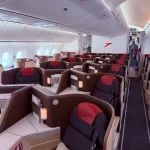If you’ve flown with Philippine Airlines (PAL) or are planning to, you may be wondering whether the airline is part of a global alliance? While major carriers often align themselves with global networks like Oneworld, Star Alliance, or SkyTeam, Philippine Airlines has taken a different route.
However, the story doesn’t stop there. PAL has a unique position in the Asia-Pacific aviation market and maintains several strategic partnerships that partially compensate for its non-aligned status. This article examines the airline’s current status, the reasoning behind its independent position, and how this affects travelers, loyalty members, and global aviation strategy.
Is Philippine Airlines Part of an Airline Alliance
No, Philippine Airlines is not a member of any of the three major global airline alliances,Oneworld, Star Alliance, or SkyTeam,as of mid-2025. Despite operating internationally with a comprehensive network across Asia, North America, Australia, and the Middle East, Philippine Airlines remains an independent carrier.
This positioning makes it one of the few full-service flag carriers in Southeast Asia not aligned with a major alliance. While this might seem like a competitive disadvantage at first glance, the decision stems from deeper strategic and operational factors.
Most international travelers expect connectivity, lounge access, and loyalty point sharing,features typically found within alliances. Yet, Philippine Airlines navigates these expectations through direct partnerships and codeshare agreements.
Join the forum thread: Philippine Airlines Alliance Status – What Frequent Flyers Need to Know
Our blog explains PAL’s current independence and partnership strategy, but the community dives deeper sharing how this affects miles, lounge access, and connection ease when flying internationally. Get firsthand advice from travelers who’ve navigated the skies with PAL and its partners.
What Are the Global Airline Alliances
To understand Philippine Airlines’ choice, it is helpful to examine the global airline alliance landscape. There are three dominant airline alliances:
| Alliance Name | Founded | Number of Members | Major Carriers |
| Star Alliance | 1997 | 26 | Lufthansa, Singapore Airlines, ANA |
| Oneworld | 1999 | 13 | Qatar Airways, Cathay Pacific |
| SkyTeam | 2000 | 19 | Delta, Air France, KLM |
Each alliance offers interline benefits, coordinated schedules, reciprocal frequent flyer programs, and lounge access. For example, a Qatar Airways passenger can earn miles on British Airways or access Cathay Pacific lounges due to Oneworld membership.
However, alliances also come with operational commitments, revenue sharing, and cost implications. This is where Philippine Airlines diverges.
Why Has Philippine Airlines Not Joined Any Alliance
Operational Control and Flexibility
Philippine Airlines prioritizes operational autonomy. Joining an alliance often requires compliance with unified scheduling, shared pricing models, and joint ventures. For Philippine Airlines, especially in a competitive region like Southeast Asia, control over pricing and route strategy remains essential.
CEO Stanley Ng, in a 2023 interview, stated that the airline prefers building partnerships based on strategic value rather than alliance mandates.
Cost Considerations
Joining a global alliance involves costs related to integration, training, marketing, and technology upgrades. For an airline still recovering from pandemic-era losses, the financial burden may outweigh the immediate benefits.
Strategic Partnerships Over Alliance Membership
Instead of full membership, Philippine Airlines pursues selective codeshare agreements. These provide shared flights, baggage handling, and loyalty benefits without the obligations of alliance membership. This hybrid model offers connectivity while preserving flexibility.
Historic Attempts and Industry Speculation
There have been speculations about Philippine Airlines entering Oneworld or Star Alliance due to codeshares with member airlines. However, no official move has occurred. Analysts suggest that internal readiness and fleet expansion are prerequisites.
Does Philippine Airlines Have Codeshare Partners
Yes, Philippine Airlines actively maintains codeshare agreements with several global carriers. Some are alliance members, while others are also independent.
| Partner Airline | Primary Region | Alliance Affiliation |
| All Nippon Airways | Japan | Star Alliance |
| Cathay Pacific | Hong Kong | Oneworld |
| Turkish Airlines | Europe | Star Alliance |
| Emirates | Middle East | None |
| Gulf Air | Middle East | None |
| Hawaiian Airlines | United States | None |
| China Airlines | Taiwan | SkyTeam |
Benefits of Codeshare Agreements
- Shared flight codes for easier booking
- Checked baggage to the final destination
- Earn and redeem Mabuhay Miles on select routes
These partnerships enable Philippine Airlines to expand its global reach without joining an alliance.
What About Mabuhay Miles? Can I Earn Points on Other Airlines?
Mabuhay Miles is the frequent flyer program of Philippine Airlines. While it’s primarily limited to PAL-operated flights, members can earn and redeem miles on select codeshare partners.
Earning potential is generally limited to flights booked through PAL or partner flights with PAL-coded flight numbers. You won’t be able to earn Mabuhay Miles on most alliance flights booked outside of PAL’s booking channels.
Elite Mabuhay members get priority check-in, additional baggage allowance, and other benefits,but lounge access and priority boarding are not consistently available when flying partners, especially outside Asia.
How Does Independent Status Affect Travelers
Philippine Airlines’ independence affects the travel experience in several ways.
Benefits
- Mabuhay Miles members can earn and redeem points with select partners
- Lounge access available in key international airports
- Seamless connections on coordinated codeshare flights
Limitations
- Elite status not recognized across alliances
- No guaranteed alliance-tier benefits such as lounge access or upgrades
- Limited support for complex, multi-airline itineraries
Travelers may find fewer perks on interline routes compared to alliance-backed journeys, but PAL mitigates this through selective high-value partnerships.
How Does PAL Compare to Alliance Members?
When compared with similar full-service Asian carriers, PAL competes well in cabin quality and service,particularly in business class on transpacific routes.
However, the lack of alliance membership means passengers miss out on:
- Seamless check-in and bag transfers across partner airlines
- Shared elite status recognition
- Global lounge access with alliance credentials
- More flexible rebooking in case of delays or disruptions
Still, PAL has invested in fleet upgrades (e.g., A350-900s, updated A321neos) and maintains solid on-time performance and one of the better soft products in Southeast Asia.
Which Other Major Airlines Are Not Part of an Alliance
Philippine Airlines is not alone in remaining independent. Several prominent carriers operate outside global alliances:
- Emirates – Maintains independence with multiple bilateral agreements
- Etihad Airways – Focuses on equity partnerships and codeshares
- Virgin Atlantic – Recently joined SkyTeam in 2023 after years of independence
- Hawaiian Airlines – Independent with strategic codeshares
These examples show that a non-aligned strategy can be viable when executed with precision.
Could Philippine Airlines Join an Alliance in the Future
Alliance membership is possible in the future. Philippine Airlines has shown interest in strategic partnerships. As its long-haul network expands or market conditions change, it could consider Oneworld or Star Alliance.
However, leadership remains cautious. The airline’s priority is operational sustainability, profitability, and customer satisfaction. Potential triggers for future membership include:
- Expansion into European or African markets
- Growth in business and corporate travel demand
- Development of premium class offerings
- Full financial recovery post-restructuring
For now, Philippine Airlines continues to operate as a selectively global, regionally strong, and strategically independent airline.
Should You Fly PAL If You’re an Alliance Loyalist?
If your top priority is maximizing points or elite perks across multiple airlines, then PAL may not be your best choice. However, if you’re focused on direct routes to the Philippines, solid onboard service, and competitive pricing, PAL remains a strong independent carrier.
For U.S.-based travelers, PAL offers some of the fastest non-stop options to Manila from Los Angeles, San Francisco, New York, and Honolulu. The experience onboard,especially in business class,is quietly competitive, with lie-flat beds, upgraded menus, and a decent wine list.
FAQs: Philippine Airlines and Airline Alliances
Is Philippine Airlines part of Star Alliance or oneworld?
No. PAL is not a member of any global airline alliance as of 2025.
Can I earn miles on other airlines with Mabuhay Miles?
Only on specific partner airlines with codeshare agreements, and usually only when booked through PAL.
Does PAL plan to join an alliance in the future?
There’s no official plan, though analysts consider oneworld the most likely fit.
Will my oneworld or Star Alliance status be honored on PAL?
No. Unless you’re flying a codeshare on a partner airline, alliance status doesn’t transfer to PAL flights.
Can I book PAL flights through partner airlines?
Yes, on select codeshare routes, but availability and benefits are limited compared to full alliance integration.





